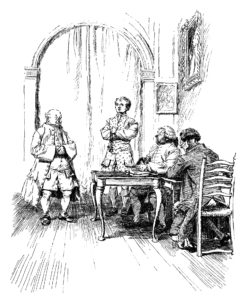
There are many jokes about committees [e.g., “A recent study concluded that the most efficient size for a working committee is 1.6 people”], but at the outset of the American Revolution, the colonists set up committees that were deadly serious.
In November 1775, our ancestor James Philemon Holcombe risked his life by agreeing to serve on the Prince Edward County, Virginia, Committee on Safety.
As the rebellion against England became ever more violent and widespread in 1774 and 1775, the authority of the Royal colonial governors disintegrated. The Committees on Safety were the first local government bodies set up by the colonists to replace British rule.
Holcombe was one of 21 men elected to the Committee. For many months, the Committee was the only functioning government for the county and it assumed broad powers, including the right to call up county residents to join the militia fighting the British.
“Give Me Liberty, Or Give Me Dealth!”
In the spring of 1776, the Commonwealth of Virginia was established at a convention in Richmond.
The Virginia legislature voted for its support of the Continental Army after Patrick Henry’s impassioned speech that ended with the famous quote:
- “Give me liberty, or give me death!”
This quote was not so much a call to arms. Patrick Henry was 40 in 1775 and did not serve as a combatant during the war. Rather, he was stating the stark reality that any politician who defied the Crown, as Holcombe did by joining the Committee on Safety, consigned himself to one of two fates:
- liberty if the Revolution succeeded, or
- execution for treason if it failed.
The Holcombes’ Revolutionary War Service
Philemone continued to serve in various positions during the revolution, including as a Justice of Prince Edward County. At the outset of the war, Philemone’s son, our next this lineage John Holcombe, joined the Continental Army as a Captain. He suffered a thigh wound at the Battle of Germantown north of Philadelphia on October 4, 1777. He returned to Virginia to recuperate, then joined the Virginia Militia in which he rose to the rank of Colonel. He fought at the Battle of Guilford Courthouse in North Carolina on March 15, 1781 – a battle that the Rev. Thomas Mullins also participated in, possibly as an Army Chaplain.
After the Battle of Guilford Courthouse, Col. Holcombe’s regiment was attached to Major General Marquis de Lafayette. Lafayette spent the summer shadowing British General Cornwallis, and Lafayette’s troops were part of the American force at the Battle of Yorktown. Yorktown ended in a catastrophic British defeat on October 19, 1781, effectively ending the war. Because Col. Holcombe had been deployed with Lafayette just 7 months earlier, it is likely that Holcombe fought at Yorktown, but we do not yet have definitive proof.
The Wedding – Mullins and Holcombe Descendants
Did Col. Holcombe and Rev. Mullins meet at Guilford Courthouse in 1781? Probably not. But their respective families were united in marriage 90 years later in 1871, far from North Carolina: in Fayetteville, Arkansas, where our ancestors William Madison Mullins and Sophia Freyschlag were married. It doesn’t seem far-fetched to suppose that William and Sophia knew of their respective ancestors’ roles in the Revolutionary War; that perhaps each had a traditional family story about the Battle of Guilford Courthouse.
© 2013 W. Mullins
